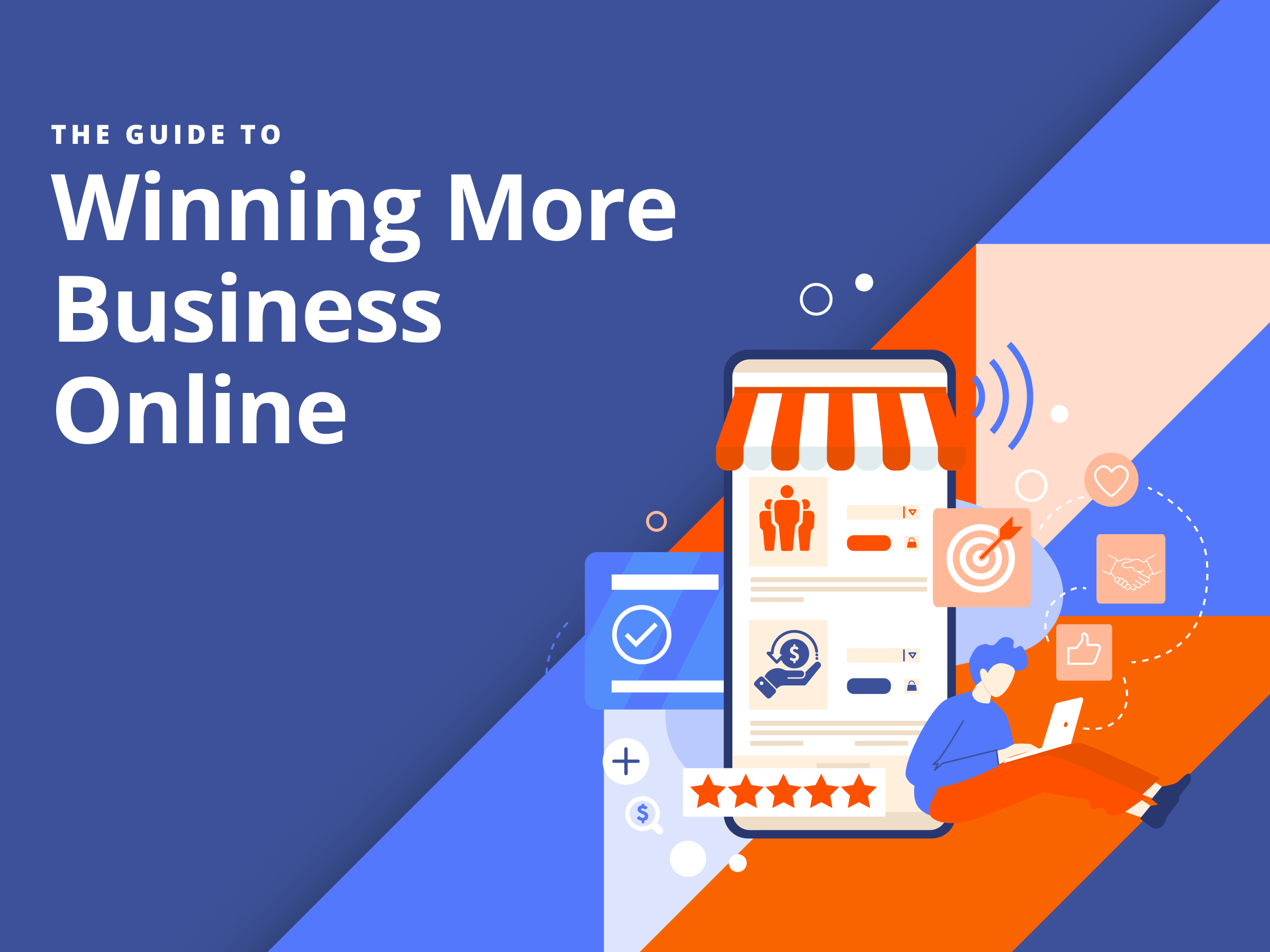“Knowing is half the battle.” – G.I. Joe
Okay, I’m pretty sure he wasn’t explaining how to identify business competitors, but stick with me here for a second.
Researching competitors is like a recon mission. You want to see who and what you’re up against before launching an attack – or, in this case, a new product or business.
In this post, we’ll explain how to identify competitors through 10 different research methods. We’ll also highlight the difference between direct and indirect competitors and how you can identify each as a small business owner.

The Guide to Winning More Business Online
Save NowHow to Identify Competitors for a Small Business
You might already have an idea of who your competitors are and what they offer. They might be located in the same town or even down the street from your business. These are direct competitors, and there’s no doubt you know a lot about them.
Indirect competitors aren’t as easy to spot, but they can have just as big an impact on your business as any other company.
Direct vs. Indirect Competitors
Direct competitors sell the same products and services that your business does. They compete directly against you by advertising to customers in your industry. These businesses are the most likely to steal your customer base because they provide the same solutions that your business does.
Indirect competitors target the same customers, but they offer different products and services. That makes them more difficult to spot, because it’s not as obvious that they are competing against you.

For example, if I ran a local plumbing business, my direct competitors would be other plumbers in my area. However, one indirect competitor could be YouTube because it provides videos that teach people how to complete simple plumbing projects without hiring a professional. Although YouTube isn’t selling any plumbing services, it could take away customers from my local business.
How to Identify Direct Competitors
Now that you know which competitors to be aware of, let’s talk about how you can identify both – starting with direct competitors.
1. Complete a market analysis.
A market analysis is a report that explains who your target audience is and who you will compete against in that industry. It’s a handy report for conducting competitor research because it clearly outlines what problem your product will solve and why your business will stand out from others in your market.
Here is an example of what a market analysis might look like. You can see that there is an entire section devoted to analyzing competitors in your industry:

2. Collect feedback from your customers.
One of the most effective ways to identify competitors is to ask your customers to point them out for you. Nowadays, consumers have options, and they can quickly turn to the internet to compare products, services, and businesses.
Before they bought from you, they probably considered another company in your industry. So, use follow-up surveys and focus groups to ask customers who else they considered working with, and if there are other products and services that they prefer over yours. Ask them what they like about these businesses, what they dislike, and where your company can over-deliver on their expectations.
3. Network with other business owners.
It never hurts to stay in touch with other business owners – especially the ones in your immediate area. Whether they are a part of your industry or not, these folks can let you know when a new business is coming to town and what you might want to know about them. They may even offer tips for marketing your products or share pain points that customers have experienced with that business.
4. Look at local listings in your area.
In addition to managing your own local listing, you should track other businesses, as well. Sites like Google and Yelp can let you know when a new business has popped up and what products and services they currently offer. You can also use their local listing to compare prices and research customer reviews, giving you additional ways to differentiate your business from this competitor.
Pro Tip: Download this free guide for managing online listings.
5. Browse social media.
You have our permission – it’s time to go down a social media rabbit hole – not for TikToks or viral dog videos, but for comments, reviews, and conversations.
That’s where you let your customers guide your research. Look at the companies they follow. Check to see if they left any reviews. If so, what did they say? What did their friends say? What did random people say about this business?
Most business accounts will have a link to their timeline and customer reviews. Here’s one from Facebook:

Consumers don’t hold back on social media, making it a great place to see what your followers think about your company and other businesses in your area.

The Guide to Winning
More Business Online
Want customers to find you online? A website is not enough.
How to Identify Indirect Competitors
Indirect competitors can be a little tricky to spot. You have to stay on top of consumer behavior and look for new trends that may challenge your industry.
1. Stay up to date with news and trends.
News and trends significantly affect consumer behavior. Take the Stanley water bottle, for example. In 2019, this 100-year-old company had about $73 million in sales. Then, in 2023, sales exceeded $750 million as Stanley bottles became the talk of the town. In 2024, sales suddenly slowed after misleading reports found lead contamination in the trendy water bottles.
The Stanley bottle did not change, nor did it revolutionize the water-drinking industry. We, as consumers, suddenly took an interest in Stanley and then quickly moved on to the next “big thing.”
That’s why staying on top of news and trends is important. If I were competing against Stanley – say, as a bottled water company – I would understand why my sales dropped while theirs were rising. I could then strategize ways to position my product as a more direct competitor to the Stanley water bottle.
2. Analyze search engine results pages.
A search engine results page is the page you’re directed to after submitting a question or keyword on Google – or Bing, DuckDuckGo, etc. It looks a little something like this:

Now, if I were an electrician, I wouldn’t be too concerned about losing jobs like “screwing in a lightbulb.” But, as you may notice, the top result is written by a lighting distributor, and below it is a wikiHow article.
The lighting distributor could be a direct or indirect competitor – depending on the size of our business and the services that we offer. But, wikiHow is a great example of an indirect competitor. It doesn’t sell anything related to electricity, yet it’s still ranking for a phrase that our customers might search for. Therefore, wikiHow would be considered an indirect competitor because it’s taking traffic away from our website.
3. Follow industry experts.
A good way to stay up-to-date on your industry is to follow the experts. Use social media channels like LinkedIn to follow people who are studying the latest trends in your marketplace. These folks love to post about projects, interesting findings, and any other noteworthy news that they’ve come across recently.
Here’s an example of an SEO specialist that I follow on LinkedIn:

4. Conduct keyword research.
If you have access to SEO tools, like SEMRush or Ubersuggest, you can see which websites rank for brand-related keywords and phrases. That’s an effective way to compare how your company gets discovered online compared to your competitors.
For instance, when I set up my website, Pedaling4Pups.com, I assumed anyone could find it by Googling “Pedaling for Pups.” I was a bit surprised to find that this keyword shared a results page with bike races, Facebook groups, and even pub crawls – Pedaling for Pubs.
Before doing keyword research, I would have never considered these sites to be competitors, but in Google’s eyes, they were. They shared the same results page that my website did for a brand-related keyword, which meant people searching for my site were also seeing these alternatives.
5. Keep tabs on the latest technology.
When it comes to much-talked-about technology, if it feels like AI is almost all you’ve heard about, you’re not imagining things. And if its surge in popularity has taught us anything, it’s that technology is changing and improving rapidly each day. As a business owner, it’s important to keep up with any tech that has the potential to revolutionize your industry. Being an early adopter will not only help you identify new competitors, but it will also give you a huge advantage over your existing competition.
Rising Above Your Competition
Now that you know who your competitors are, the next step is to differentiate yourself from them. Figure out what makes your products and services unique, and why customers should choose your business over their alternatives.
Over time, continue to keep track of competitors in your industry. New businesses will pop up, old competitors might close their doors, and who knows what the next viral trend will be? The more you stay updated on your research, the more prepared you will be to handle whatever competition you face.

The Guide to Winning
More Business Online
Want customers to find you online? A website is not enough.







